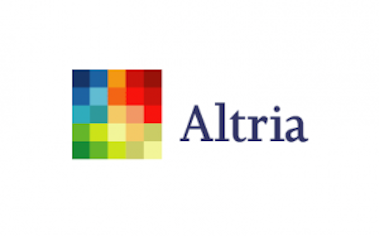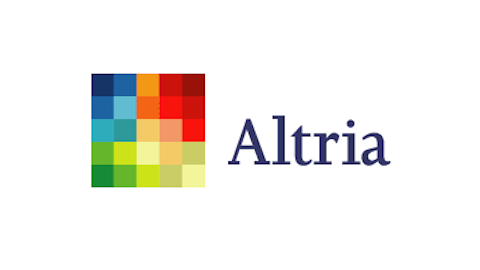
But if your conscience allows you to own the stock of a company that produces cigarettes and other tobacco products, you may be surprised at the returns you receive.
Consider the two biggest names in the industry: Altria Group Inc (NYSE:MO) and Philip Morris International Inc. (NYSE:PM). Altria is actually the parent company of Philip Morris, having spun off the firm in 2008. While Philip Morris International Inc. (NYSE:PM) is strictly a tobacco company, boasting seven of the top 15 brands and selling its products in 160 countries, Altria Group Inc (NYSE:MO) is a bit more diversified. Altria also produces and sells blended table wines under several brand names, and maintains a portfolio of leveraged and direct finance leases in aircraft, rail and surface transport, electric power, real estate, and manufacturing.
Performance and valuation
Altria just hit a 52-week high on May 1 of $36.91, and is currently yielding 4.8% (versus a 5 year average of 6.5%). The stock has been fairly up and down since July 2012, when it marked a previous 52-week high of $36.25. In the last three years, it has nearly doubled in value and has returned 80% in the past five years. Meanwhile, it currently trades at a price to earnings ratio of 17.6, and in the last 12 months, Altria Group Inc (NYSE:MO)’s return on assets was 11.8%, its return on investments was 26.8% and its net profit margin was 17%. Over the last five years it has averaged an annual ROA of 11.3%, ROI of 26.1% and net profit margin of 20%. All of these ratios and metrics show a healthy company, and one that could continue to grow over the coming years, especially with its diverse investments.
However, one concerning sign for Altria, is its debt, with its total debt more than four times its equity. It also has very little liquidity, as evidenced by a low quick ratio (0.40) and current ratio (0.80). Finally, analysts are mixed on the future of Altria Group Inc (NYSE:MO), with three have “strong buy” ratings, five have “buy” ratings and six have “hold” ratings
Philip Morris, however, shows a slightly different story. Its stock has been twice as volatile in the last three years, as measured by the companies’ beta (0.46 for Altria Group Inc (NYSE:MO); 0.86 for PM). Although it set a 52-week high on May 1 of $96.73, it has taken its investors on a bumpier ride to get there, but is still yielding 3.6% (versus a 5 year average of 4.3%). Still, in the last three years the stock has slightly more than doubled in value and nearly tripled in five years. While this shows good growth, many are concerned about future potential, given the tobacco industry overall. In terms of valuations and metrics, Philip Morris International Inc. (NYSE:PM) is is good as well.
It currently has a price to earnings ratio of 18.4, and in the last 12 months, Philip Morris International Inc. (NYSE:PM) earned an ROA of 24.3%, an ROI of 64.6% and net profit margin of 11.7%. Its average profit margin for the last five years was 11.2%, while its average ROA was 22.2% and its ROI was 46.2%. Similarly to Altria Group Inc (NYSE:MO), Philip Morris International Inc. (NYSE:PM) has some liquidity and debt concerns, with negative equity of $3.48 billion, a long-term debt load of $17.64 billion, and only $3 billion in cash as of the end of 2012. Similarly to Atria, Philip Morris analysts are mixed: five have “strong buy” ratings, six have “buy” ratings, and seven have “hold” ratings.
For many people, an investment in a tobacco company is a risky investment. With people pushing towards a healthier lifestyle, and government campaigns against tobacco and smoking, there are plenty of reasons to be skeptical. However, these companies have showed growth in the past, and could continue to grow in the future. Additionally, some people may not have the money to buy many stocks individually. For these people, an ETF is a great way to gain exposure to these companies, as well as other companies in the same industry (or whatever industry you want). Additionally, ETFs provide good diversification within a specified market, and can avoid many of the diversification problems associated with picking individual stocks.
To invest in an exchange-traded fund with either or both of these companies, you will need to find ones that are invested in consumer staples. Below are two examples. However, these companies are held by many ETFs, so do not limit yourself to these alone.
Launched in December 1998, Consumer Staples Select Sector SPDR Fund corresponds with the S&P Consumer Staples Select Sector Index. It has an expense ratio of 0.18%. It has 43 stocks among its holdings, including Philip Morris as the third-largest holding (10.16%) and Altria as its seventh-largest (4.27%). The fund has a year-to-date return of 18.23%, a one-year return of 23.18%, a three-year annualized return of 17.42%, a five-year annualized return of 10.93%, and a 10-year annualized return of 10.45%.
Launched in January 2004, Vanguard Consumer Staples ETF has 103 stocks and tracks the Vanguard Consumer Staples index. Philip Morris International Inc. (NYSE:PM) accounts for 8.8% of its holdings, the third highest, and Altria Group Inc (NYSE:MO) accounts for 4.16%, the seventh highest.
The takeaway
Overall, whether you are interested in Altria or Philip Morris International Inc. (NYSE:PM), it is good to understand these companies, the industry, and the role these companies can play in your portfolio. Perhaps the most important part for any portfolio is remaining diversified, and companies such as Altria and Philip Morris, and especially ETFs, can help you achieve this goal.
The article Tobacco Industry: A Healthy Investment? originally appeared on Fool.com and is written by Daniel Murray.
Copyright © 1995 – 2013 The Motley Fool, LLC. All rights reserved. The Motley Fool has a disclosure policy.


